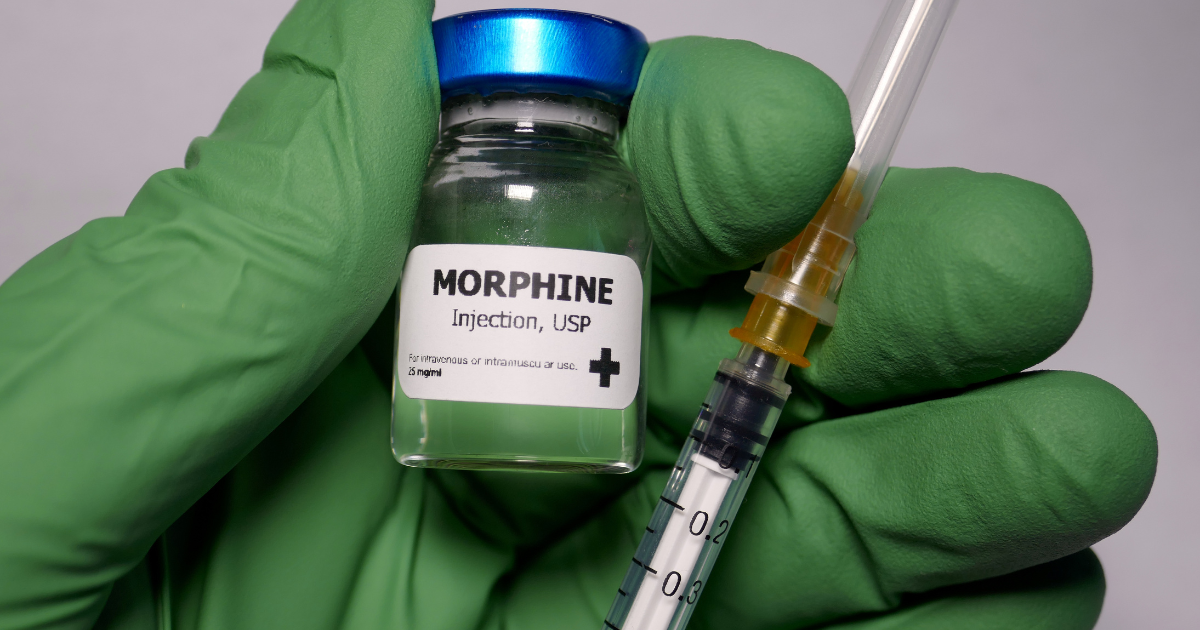Morphine usually lasts around 4 to 8 hours in the human body. This potent opioid pain medication commonly manages severe pain in some patients. The drug is legal with a prescription and is prescribed for severe pain cases that need management by something stronger than something like acetaminophen or ibuprofen.
Both healthcare providers and patients must understand how long it stays in the system, especially when ensuring that they take the correct dose to manage pain and avoid abuse. Let’s explore the factors influencing how long morphine remains in the body and the implications for pain management, opioid withdrawal, and addiction recovery.
What Is Morphine?
Morphine is an opioid pain medication derived from the opium poppy plant. It’s one of the oldest, most powerful pain relievers used in medicine. The opioid binds to specific brain and spinal cord receptors, blocking the pain sensation.
Common Medical Uses
Morphine is commonly administered for the following medical uses:
- To relieve pain after surgery
- During cancer treatment
- To manage chronic pain conditions.
While highly effective in pain management, morphine also has a potential for dependence and addiction. Its use must be carefully monitored, particularly for those with a history of substance abuse.
The drug’s ability to produce euphoric feelings can lead to misuse, underscoring the importance of proper medical supervision.
The History of Morphine
Morphine’s history is rich and complex, dating back to the early 19th century. Here’s an overview:
- Early Discovery: Morphine was first isolated in 1804 by Friedrich Sertürner, a German pharmacist. He named it after Morpheus, the Greek god of dreams, due to its sedative (soothing) properties.
- Medical Adoption: By the mid-1800s, morphine was commercially produced and became widely used for pain relief, especially during the Civil War, to treat battlefield injuries.
- Development of the Hypodermic Syringe: The invention of the hypodermic syringe in the 1850s allowed for easier administration of morphine, revolutionizing pain management in medical practice.
- Rise of Dependence: The widespread use of morphine via hypodermic needles led to increasing reports of dependence and addiction, particularly among war veterans and medical professionals.
- Regulation: In response to growing concerns, the U.S. government began regulating morphine and other opioids through the Harrison Narcotics Act of 1914 and subsequent legislation.
- Modern Use: Today, morphine is an essential pain management tool, used under strict regulations and guidelines to minimize abuse and addiction risks. Morphine’s usefulness has, however, declined over the years. Other, better drugs are usually prescribed in its place.
Morphine’s Half-Life
Morphine’s half-life is usually around 2 to 4 hours. On average, half of the drug leaves the body within this time frame. Each patient has a variety of factors that can change the half-life, including:
- Age
- Metabolism
- Liver function
- Kidney function
Different Types of Drug Tests for Morphine
Regular drug testing methods that test for opioids will show morphine.
- Blood Test: The blood can show morphine up to 12 hours after use.
- Urine Test: The urine can reveal morphine for 2 to 3 days after consumption.
- Saliva Test: The saliva can contain morphine for 1 to 4 days.
- Hair Test: This method can uncover morphine for up to 90 days.
Factors Influencing Morphine Detection
- Metabolism Rate: A person’s metabolic rate dramatically affects how quickly the body processes morphine.
- Frequency of Use: Chronic users, especially those who abuse morphine for the opioid effects, may experience a longer detection period compared to occasional users.
- Body Fat: Morphine’s storage in fat cells affects a person’s body fat percentage and detection times.
- Age and Health: Younger, healthier individuals typically process morphine faster.
What Are the Symptoms of Morphine Addiction?
Morphine addiction can develop gradually, and recognizing the symptoms early is crucial for effective intervention and recovery. Here’s what to look out for:
- Physical Dependence: Frequent cravings, increased tolerance (requiring more of the drug to achieve the same effect), and withdrawal symptoms when not using the drug.
- Behavioral Changes: Shifts in behavior such as neglecting responsibilities, withdrawal from social activities, secretive behavior, and prioritizing drug use over other interests.
- Health Issues: Unexplained weight loss, frequent drowsiness, constipation, nausea, and other health problems associated with regular morphine use.
- Financial Difficulties: Spending significant money to obtain the drug, even at the expense of necessary expenses like rent or bills.
- Legal Problems: Engaging in illegal activities to obtain morphine, such as forging prescriptions or buying it on the black market.
- Psychological Symptoms: Anxiety, depression, mood swings, and other mental health symptoms that may be exacerbated by morphine addiction.
- Overdose Risk: Increasing the risk of overdose, especially when taken in higher doses or combined with other substances like alcohol.
Recognizing these signs early and seeking professional help is crucial for successful recovery. Morphine addiction is a serious and complex issue that requires a comprehensive and individualized approach.
Implications for Recovery
Understanding how long morphine stays in the system is essential for anyone recovering from opioid dependence. Comprehensive monitoring, proper timing of medications, and ongoing support are the key elements for success in recovery.
At Landmark Recovery, our dedicated team creates personalized treatment plans for individuals battling opioid dependence. Using evidence-based approaches, we guide patients on their journey to recovery.
Finding Opioid Addiction Recovery
Numerous factors, including metabolism, frequency of use, body fat, and overall health, influence how long morphine stays in the system. Patients and healthcare providers must recognize these factors to manage pain in clinical situations effectively. Stronger opioids like oxycodone often lead to dependence if misused, which can also manifest itself as opioid addiction.
If you or a loved one requires assistance with opioid recovery, contact Landmark Recovery at 888-448-0302. We’re ready to assist you every step of the way.

Choose Recovery Over Addiction
We're here 24/7 to help you get the care you need to live life on your terms, without drugs or alcohol. Talk to our recovery specialists today and learn about our integrated treatment programs.




